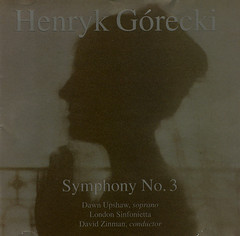Henryk Górecki
Symphony No. 3 - Opus 36 (1976)
Elektra Nonesuch

I know bupkis about classical music. I do know I tend to favor 20th century composers overall, and one of my favorite pieces of music is Henryk Górecki's Symphony No. 3.
I originally heard it on a coworkers taped-off-of-the-radio classical mix tape and neither of us could figure out who it was or where it came from. later I heard a bit of it (the second movement, probably the most beautiful, moving piece on the disc) used in a film. But rather than attempt to describe it and display my deep ignorance of classical music, I'll let Wikipedia do it for you:
Henryk Górecki - Symphony No. 3
For those interested, Moogpower (who inspired this post) has got more Górecki available here.
Elektra Nonesuch

I know bupkis about classical music. I do know I tend to favor 20th century composers overall, and one of my favorite pieces of music is Henryk Górecki's Symphony No. 3.
I originally heard it on a coworkers taped-off-of-the-radio classical mix tape and neither of us could figure out who it was or where it came from. later I heard a bit of it (the second movement, probably the most beautiful, moving piece on the disc) used in a film. But rather than attempt to describe it and display my deep ignorance of classical music, I'll let Wikipedia do it for you:
The first movement, at twenty-six minutes, equals the combined lengths of the second and third movements, and is based on a late fifteenth century lament from the Lysagora Songs collection of the Holy Cross Monastery, a prayer revolving around a mother mourning the loss of her son to revolutionary battle. Comprising three thematic sections, it opens with bass, then followed by a string motif that subdivides over it's course, building into ten separate voices playing that single motif at ten separate times. The climax of these voices is the second section libretto, followed by a gradual return to the plaintive basses that opened the first section.
The nine minute second movement is written for soprano, with libretto formed from a prayer found incripted on a cell wall in the basement of the Gestapo's Zakopane headquarters, signed "Helena Wanda Blazusiakówna 18 years old, imprisoned since 26 September 1944". The soprano voice is dominant, supported by strings that ache until a final resolution, a chord held without diminuendo for over two minutes.
The third movement is taken from a Opole folk song and again the subject matter is a mother's prayer for a lost son. The tempo of this movement is higher paced than the previous two and subtle changes in dynamism and mode make it a deceptively complex and involving piece.
Henryk Górecki - Symphony No. 3
For those interested, Moogpower (who inspired this post) has got more Górecki available here.



1 Comments:
Cool!
I'm glad you got it, it's one of my favorite albums, even though it makes my wife anxious that I'm going to start listening to opera.
Post a Comment
<< Home